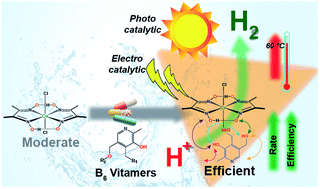The rational inclusion of vitamin B6 boosts artificial cobalt complex catalyzed green H2 production†
Abstract
Hydrogen (H2) production from water via electrocatalytic or photocatalytic pathways has been suggested as a vital step in developing a renewable-based energy landscape in the future. Bio-inspired synthetic catalyst design has emerged as one of the leading methodologies in the pursuit of efficient all-weather molecular catalysts for promoting green H2 production. The appropriate inclusion of outer coordination sphere (OCS) features, a hallmark of enzyme architecture, around a synthetic core has resulted in new types of active H2 production catalysts. However, the only biomolecules that have been explored for this OCS role are amino acids and amino-acid-derived peptide and protein motifs. Here, we have rationally incorporated vitamin B6 molecules, featuring alcohol, amine, and phosphate groups on a pyridinyl framework, around a cobaloxime center to generate a first-of-its-kind synthetic catalyst containing non-amino-acid-based biomolecules in the OCS. The resultant complexes displayed significant H2 production abilities from water at elevated temperature and oxygen exposure levels and under natural solar irradiation, while displaying the best energy efficiencies observed from a cobaloxime core to date. Among these complexes, the B6 vitamer pyridoxamine-bound complex illustrated superior catalytic performance under both photocatalytic (TON: 132) and electrocatalytic (TOF: 3635 s−1, overpotential: 321 mV, at 60 °C) conditions. Pyridoxamine preferentially binds to the cobalt core via the amine functionality instead of the typical pyridine, which resulted in an enhanced OCS effect on catalysis, presumably due to spatial proximity and the dynamic flexibility of the peripheral groups.



 Please wait while we load your content...
Please wait while we load your content...